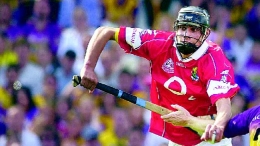New Zealand native Tony Watene’s task is to ensure that the GAA actively include minorities and immigrants – and stamp out racism. In an exclusive interview with METRO ÉIREANN, he lays out his vision for diversity within Gaelic games
 Metro Éireann: It’s been said that you first got interested in GAA while in your native New Zealand – is this true?
Metro Éireann: It’s been said that you first got interested in GAA while in your native New Zealand – is this true?
Tony Watene: Yes, I was first introduced to Gaelic games through Australian Rules football when I was in secondary school. There were a number of Irish ex-pats and people on working holidays in the team and they asked me to try their native game of Gaelic football.
My ever first game of Gaelic took place on an Aussie Rules pitch in Wellington. Afterwards, the friendly mix of Irish and Kiwi (both Pakeha & Maori) retired to the Hutt Valley/Wellington GAA Club where the tricolour and old photos of famous GAA county champions graced the walls. It was a purpose-built facility constructed by the large number of Irish builders who had emigrated to New Zealand in the 1980s.
I’ve never stopped playing GAA since then. I represented my county on numerous occasions, playing against the likes of Sean Wight, and Jim and Brian Stynes to name a few, and I’m currently a member of Na Fianna GAA Club in Glasnevin.
When did you first come to Ireland and in what capacity? What were your first impressions of the country?
I came to Ireland on a working holiday in December 1999 with my Kiwi partner – and I wish I could say that I never stopped holidaying, but actually I never stopped working! I joined the GAA soon after I arrived as an administrator, and have worked there continuously for the past decade.
My first impression of Ireland was that life seemed to be one big party – but most of that could be attributed to the number of Christmas celebration spilling out into Dublin’s streets. Still, even after the Christmas delirium had died down, I was overwhelmed by the positivity in the air and presumed prosperity of the people. It made a fascinating change from being back ‘home’, where our little economy always seems to just struggle along.
New Zealand is a very multicultural country made up of people from many different ethnic backgrounds, so I was initially surprised about how homogenous Ireland was. For the first year after we arrived, it seemed that almost everyone I encountered was white and Irish. As a New Zealand Maori, I found being among a sea of white faces a little strange but I certainly didn’t feel threatened by it. I was welcomed wherever I went and never experienced any situations where I was treated in a negative way because of my colour.
When were you officially appointed as the GAA’s inclusion officer, and what exactly is your remit?
I was appointed to my current position in April of this year. My remit covers many areas, one of them being the establishment of an inclusion and integration committee. In this context, integration means closer working relations between the different Gaelic games. Inclusion is about enabling all sectors of society to participate in Gaelic games – as players, administrators, coaches and referees.
Another area is the ‘Give Respect – Get Respect’ initiative, which aims to build respect both on and off the sports field by instilling core values from an early age. It is embedded in at underage level first through primary schools’ games. It covers such areas as good sportsmanship, respect for and from players and spectators, and deference for referees decisions.
What action, under official GAA policy, is taken against officials or players who engage in racism in either the dressing rooms or on pitches?
The GAA Code of Best Practice in Youth Sport and our Joint Code of Behaviour state that our players and officials shall “respect fellow members regardless of ability, ethnic origin, cultural background or religion.” Furthermore, our codes state that language of a racial or sectarian nature is unacceptable.
The association’s commitment to anti-racism and anti-sectarianism can also be gleaned from a new rule in our official GAA Rule Book 2009, in which we state that “any conduct by deed, word or gesture of a sectarian or racist nature against any player, official, spectator or anyone else … shall be deemed to have discredited [the GAA].”
Breaches are subject to varying degrees of penalty [either suspension, disbarring or expulsion from the association –ed] but it is important to state that matters such as these are always discussed in detail and in a proactive manner during training of our coaches and other personnel, and when our Code of Behaviour is being explained at underage level to younger players, mentors and to the parents of our underage players.
Last year, a young Éire Óg player in Carlow was racially abused. What action was taken by the GAA?
The incident in Carlow last year was strongly condemned by the association. Officials from the Carlow County Board met with the player and his parents and with the club in question. The perpetrators were not members of the GAA and could not be suspended. Following the incident, a policy statement was placed in all subsequent match programmes for games that were played in Dr Cullen Park.
I don’t know if you are aware of this, but in 2006 the GAA, in conjunction with Killester College, devised the FETAC-certified Stewards’ Course. Croke Park stewards were the first of any stewards in Ireland to receive such an award. As part of my remit, I intend to ensure all stewards in main GAA stadiums receive this course, which has a module on inclusion and how to deal with incidents such as the above.
Strategic plans on inclusion are welcome, but many sports observers – across the codes – say they are often not put into action. How are you ensuring that the GAA does not let its particular plan gather dust? And are there some concrete examples of the GAA bringing its policies into fruition?
All the GAA codes have clearly defined targets under the inclusion and integration strategy, and personally I have ‘key performance indicators’ that measure my progress in ensuring those targets are met.
I am proud of what we have already accomplished in the four short months since the launch of the strategy. We have pulled together a well-respected, passionate committee of individuals who are 100-per-cent committed to the on-going success of the strategy.
There is also camogie’s ‘Puck Around Town’, a six-week introductory course for inner city girls aged 10-14 from disadvantaged areas within Dublin. The programme gives these girls the opportunity and encouragement to participate in camogie.
Part of the inclusion strategy is to forge stronger relationships with the ethnic-led media, with a view to reaching out to their non-Irish audiences and letting them know more about Gaelic games. As such, we have invited several journalists from major non-Irish national publications to attend and report on major matches taking place at Croke Park during August.
We’ve also organised for Trinity Immigration Initiative’s Minority Leaders photo exhibition in Croke Park from this weekend until the end of November. This seeks to raise awareness of various key minority group leaders among the general public.
Given the high footfall at Croke Park over the coming months, as the GAA, ladies’ football and camogie play their final matches, and soccer and rugby internationals are staged later in the year, we feel that it is an effective way for the GAA to help showcase the work of minority groups and individuals and to spread the inclusion message throughout the wider community.
Children of different backgrounds often get involved in the GAA as a natural process – but immigrant adults would likely need active persuasion. How is the GAA facilitating this?
The GAA recognises that adults sometimes need more encouragement than children to break out of the mould and try new things, so we have adopted the Ulster Council’s ‘Have-a-Go Day’ programme, which brings together adults from various backgrounds and encourages them to try out Gaelic games.
The Ulster Council actively targets businesses with a large proportion of employees from minority ethnic backgrounds and runs competitions in which the employees represent their company or area in Gaelic games.
Successful ‘Have-a-Go Day’ pilots have also been held at county board level in Louth and at club level in Clan na Gael Fontenoy in Ringsend, Dublin.
What proportion of its annual budget is the GAA spending on promoting and activating inclusion?
This year, games development received €9m from the Irish Sports Council. The ethos of games development is to maximise participation and optimise playing standards. When it comes to participation, inclusion is not treated separately. It is fully encompassed in all activities of the codes.
Over the course of your time in Ireland, do you think the country has come to grips with its burgeoning diversity?
Ireland has not yet come to grips with its burgeoning diversity, but I don’t expect that it could have in such a short timeframe.
Mass immigration into Ireland is a relatively new phenomenon and the change in Irish society has been both rapid and significant. But Ireland has done very well at trying to keep pace with the changes, especially when times were good.
I think that the real challenge lies now and into the future. It is common in times of economic downturn for countries to become increasingly nationalist and protectionist.
I would be very disappointed to see the land that really did open its arms to me when I first arrived change to one that turns against its new family members, friends and neighbours coming from other countries, languages and cultures.











